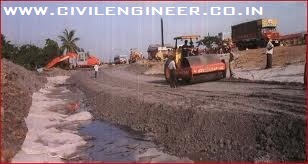

STABILIZATION OF SOIL WITH LIME & FLYASH
MECHANICS OF SOIL STABILIZATION
The term soil stabilization means the improvement of the stability of bearing power of the soil by the use of controlled compaction, proportioning under the addition of suitable admixtures or stabilizers. Soil stabilization deals with physical, physicochemical and chemical methods to make the stabilized soil serve its purpose as pavement component material.
The basic principles in soil stabilization may be stated as:
1.Evaluating the properties of given soil.
2.Deciding method of supplementing the lacking property by the effective and economical method of stabilization.
3.Designing the stabilized soil mix for intended stability and durability values.
4.Considering the construction procedure by adequately compacting the stabilized layers.
Soil stabilization may result in any one or more of the following changes:
Increase in stability, change in physical properties like density or swelling, change in physical characteristics.
Change in chemical properties:
Retaining the desired minimum strength water proofing.
Based on the above properties the various techniques of soil stabilization may be grouped as follows:
Proportioning Technique:
Various locally available soils and aggregates are mixed in suitable proportions and compacted to serve desired objective.
Cementing Agents:
The strength of the stabilized soil can considerably be increased by the addition of cementing agents like Portland cement, lime or lime-fly-ash. Bituminous materials also impart binding effect to non-cohesive soils.
Modifying Agents:
If the stabilizer added in small proportion could modify the undesirable properties of certain soils (such as highly clayey soils) making them more useful as construction material, such stabilizers may be called modifiers. The most common modifier used in the case of highly plastic soils is lime. Portland cements also acts as modifier in some cases.
Water Proofing Agents:
A compacted soil mass which is stable enough may become weaker or softer by the ingress of water or when subjected to soaking conditions. If the absorption of water can be stopped or retarded by means of some water-proofing agent, it will be possible to make use of such materials with advantage. The most common method of water proofing is by the use of bituminous materials.
Water Retaining Agents:
Some-non-cohesive soils have sufficient stability when the compacted layer possesses slight moisture content, but the soil may become loose and less stable when completely dried. In such cases use of materials with deliquescent properties, like calcium chloride is likely to be useful to retain some moisture to impart some apparent cohesion and thus retain the stability. This incidentally can also reduce the dust nuisance in un-surfaced roads.
Water Repelling Agents:
Almost the same function as water proofing agent may be performed by the water repelling or retarding agents like organic compound (Vinsol resin and other resinous materials).
Heat Treatment:
Thermal stabilization has different useful aspects as regards clayey soils. There are desirable changes in some of the properties and heat treated soil may be used in a number of ways.
Chemical:
There are several chemicals, which when added single or in combination, even in trace quantities (less then 0.5 percent by weight of soil) may impart useful changes in certain types of soils. However considerable investigation and care is needed before adopting any of costly chemicals.
In all the above methods, adequate compaction of the stabilized layers is the most essential requirement.
